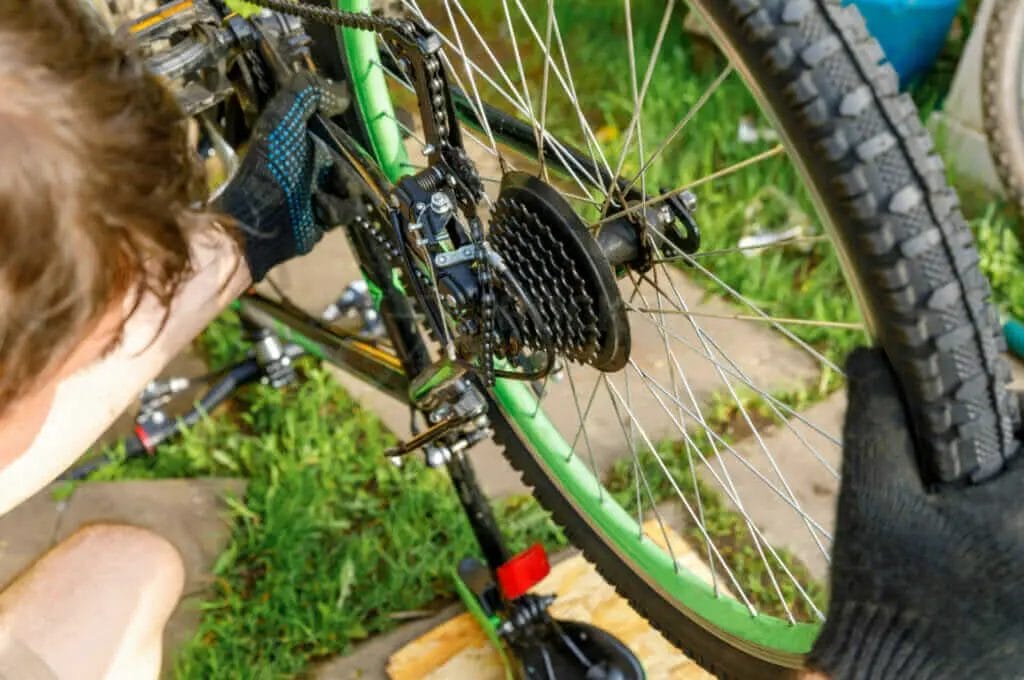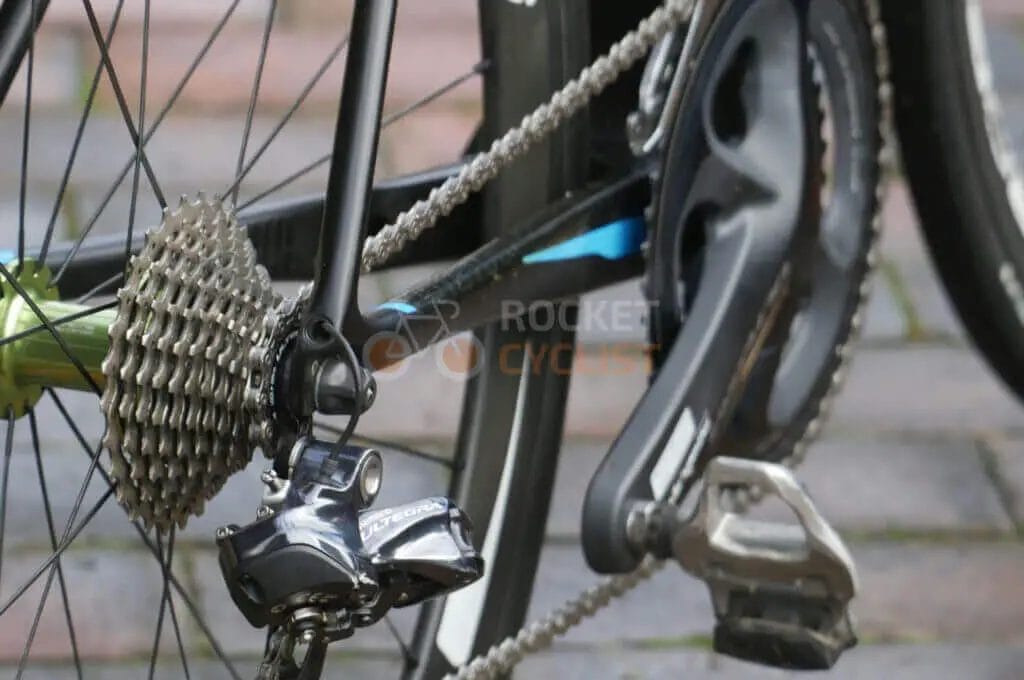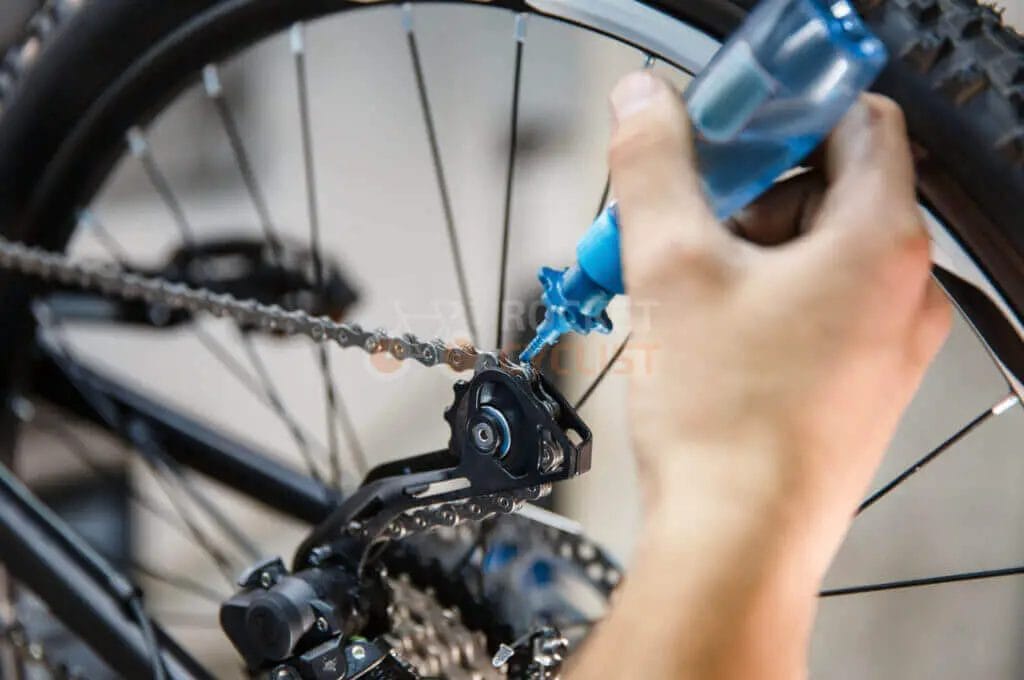Last Updated on February 28, 2024 by Vinson Lozano

Introduction to Bike Chain Lubrication
You know how important it is to keep your bike chain well-oiled; it’s an essential part of bicycle maintenance that ensures smooth rides and prolongs the life of your bike’s drivetrain. But, as in many aspects of life, more isn’t always better.
Importance of Proper Bike Chain Lubrication
When you lubricate your bike chain correctly, it reduces friction, which means less wear and tear. It also keeps the chain from rustling up an unwanted symphony every time you pedal. Proper lubrication can make pedaling easier and, ultimately, save you energy during your ride. It can protect the chain from the corrosive effects of salt and moisture, delaying rust and its unsightly but inevitable crunch.
Effects of Using Too Much Lube on a Bike Chain
Excessive lube can be a real drag – literally. When you apply too much lubricant, it attracts more dirt, grime, and particles, which can turn your chain into a grinding paste that speeds up wear. With gunk building up, your drivetrain’s efficiency plummets, making your pedaling harder than necessary. This not only affects your riding experience but also adds undue stress to your gears and chain, potentially leading to costly repairs down the road. Plus, cleaning up a chain dripping with excess lube is a grimy task. So remember, a little lube goes a long way; apply sparingly and wipe off the excess to maintain a sleek, efficient bike chain.
Understanding Bike Chain Lubrication

Suppose you’ve ever over-zealously lubricated your bike chain, thinking “more is better.” In that case, you may have set yourself up for a bit of a predicament. By applying too much lube, you inadvertently create a sticky trap for dirt and debris. This muck clings to your chain and gears, diminishing the very performance you aimed to enhance.
While your intentions were good, an overly generous lube application can turn your bike chain into a magnet for grime. The particles that accumulate form an abrasive slurry that grinds away at the chain links and rollers with each pedal stroke. It’s like slowly sanding down your drivetrain, which naturally accelerates the wear and tear process.
Moreover, too much lube can make for a messy ride, flinging lubricant onto your bike frame, wheels, and even your leg as you cycle. The situation can be exacerbated in wet conditions, where excess lube mixed with road spray creates a particularly sticky concoction.
Cleaning up this oily grime from your chain and bike components can be a dirty and time-consuming task that no cyclist enjoys. It means more maintenance work, more often. And should you neglect the clean-up, prepare for a compromised riding experience and the wallet-draining prospects of replacing your drivetrain components prematurely. So, it pays—both in terms of ride quality and your hard-earned cash—to be measured and precise when lubricating your bike chain.
Different Types of Bike Chain Lubes
When it comes to choosing a chain lubricant, know that not all lubes are created equal. Based on your riding conditions, you’ll typically select between wet, dry, or all-conditions lube. Wet lubes are stickier and are ideal for wet and muddy conditions but can attract more debris in drier climates. In contrast, dry lubes are lighter and better for dry environments, though they require more frequent application. All-conditions lubes aim to strike a balance between the two but may not excel in any one scenario.
Proper Application of Bike Chain Lube
To properly lube your bike chain, start by cleaning it thoroughly to remove old lube and grime. Once clean and dry, apply a modest amount of lube, targeting the rollers of the chain—this is where the magic happens. As you apply, turn the pedals to ensure you’re evenly distributing the lubricant. Then—and this is crucial—wipe away the excess. You want the lube in the rollers, not coating the chain’s exterior, where it’s a dirt magnet. By following these steps, you keep your chain functioning smoothly without turning it into a liability.
Signs of Excessive Lube on a Bike Chain

If you’re enthusiastic about bike maintenance, it can be tempting to apply liberal amounts of lubrication to ensure smooth riding. However, too much lube can lead to some tell-tale problems. Let’s delve into what could happen if you go overboard with lubricating your bike chain.
Visible Buildup of Lube on the Chain
One of the first indicators that you’ve applied too much lube is a visible accumulation on the chain. It may look greasy and feel slippery to the touch. This excess can not only detract from the look of your bike, but it also serves no functional purpose. Instead, it acts as a dust magnet, compromising the efficiency and lifespan of your chain.
Increased Dirt and Debris Accumulation
When you’ve got too much lube on the chain, it starts picking up dirt and debris like a lint roller. This can happen almost instantaneously as you begin your ride. You might notice that after a once-over with excessive lube, the chain looks dirtier and grittier than ever before. This quickly leads to a grinding paste that wears down the chain and gears.
The bottom line: apply your bike chain lube sparingly and wipe off the excess to avoid these issues. Remember, a little goes a long way when it comes to keeping your bike in top condition.
Negative Effects of Over-lubrication

When you go overboard with lubricating your bike chain, the negative consequences are not just immediate but also progressive, leading to long-term issues with your bicycle’s performance. From a maintenance perspective, you need to understand the balance between adequate lubrication and overdoing it. Excessive lube can lead to problems that, if left unchecked, could result in costly repairs or replacements.
Attracting more dirt and grime
As you coat your chain with an overabundance of lubricant, what you’re actually doing is creating a sticky trap for dirt, dust, and grime. It’s a common misconception that more lube equals smoother rides; reality tells a different story. The excessive lube forms a tacky surface that grabs anything it comes in contact with, from the fine road dust to the more abrasive particles. This accumulation not only negates the very purpose of lubrication but also lets these unwanted particles reach the inner workings of the chain links, which can cause lasting damage over time.
Increased chain wear and corrosion
And perhaps the most disconcerting part of over-lubricating your bike chain is how it accelerates the wear and tear process. Each time you pedal, that excess lube, mixed with dirt and grime, works as an abrasive compound that slowly grinds away at the metal. As if that’s not bad enough, a heavily lubed chain can actually retain moisture, leading to corrosion that weakens the integrity of your chain. This means more frequent adjustments, or worse, snapped chains in the middle of your ride. Save yourself the hassle—and a potential walk home—by applying a moderate amount of lube and wiping away the excess diligently.
Potential Performance Issues
Over-lubricating your bike chain can have several unintended side effects that impair your bike’s performance and your overall cycling experience. By understanding these potential issues, you can ensure that your maintenance routine is supporting, not hindering, your ride.
Decreased Shifting Accuracy
If you put too much lube on a bike chain, you may start to notice that shifting gears isn’t as smooth or precise as it once was. An overly greased chain can cause a build-up of grime between the shifters and the derailleur. The excess lubricant masking these components can diminish the responsiveness of the gear-shifting mechanism, leading to missed gear changes, frustrating slips, or sudden and unexpected shifting. This is not only annoying but can also become dangerous if it occurs while you’re navigating traffic or during a strenuous climb.
Reduced Power Transfer Efficiency
A slick of excessive lubricant on your chain can create an energy-sapping effect. Instead of a clean transfer of power from your legs to the wheels, an over-lubed chain allows for slippage, and with each pedal stroke, you could be losing a small but critical amount of energy. This inefficiency means that you have to work harder to maintain your speed or to accelerate. During a long ride, this can contribute to quicker onset of fatigue and decreased overall performance. To make the most of your effort and to ensure a smooth, efficient ride, it’s crucial to apply lube sparingly and to your bike chain’s specific needs.
Proper Lubrication Techniques

Paying close attention to the amount of lubricant you apply to your bike chain is essential, as overdoing it can lead to a range of issues that affect your cycling performance. Now let’s delve further into what happens if you put too much lube on your bike chain and how you can avoid these pitfalls through proper lubrication techniques.
Using the right amount of lube
When you over-lubricate your chain, it becomes a magnet for dirt and debris. If you’re cycling on dusty trails or gritty city streets, the excess lube can quickly turn into a grinding paste that wears down your chain and gear sprockets faster than normal. This means more frequent maintenance and potential replacements, hitting your wallet as well as your bike’s performance. Moreover, the viscous nature of excessive lube can attract more dirt and dust than necessary, compromising the chain’s integrity over time. You want to apply just enough lubricant to coat the chain without it dripping off. A good rule is to add a drop of lube per link, and then pedal backwards several times to allow it to seep into the inner rollers.
Wiping off excess lube after application
Once you’ve appropriately applied the lubricant, the next critical step is wiping off any excess. Simply take a clean, dry cloth and gently run it over the length of the chain. This will remove surplus lube that, if left, could attract additional dirt and lead to the type of build-up and wear mentioned earlier. Remember, the goal is to lubricate the chain, not drench it. By wiping away the extra lubricant, you’ll help maintain a crisp, efficient drivetrain and protect your components from premature degradation. In essence, this step can significantly extend the life and efficiency of your bike’s chain, ensuring smoother rides and more enjoyable cycling adventures.
How to Fix an Over-lubricated Bike Chain
If you find that your bike chain has an excess of lubricant, it’s imperative to address this as soon as possible. Over-lubricating the chain can cause it to gather an excess of grime and dirt which, in the long run, can cause more harm than good. This situation can degrade your bike’s performance and even lead to expensive repairs. Here’s what you can do to remedy this issue effectively.
Cleaning the chain thoroughly
Your first step should be to clean the chain thoroughly. You’ll need a good quality degreaser and a brush or a cleaning tool specifically designed for bike chains. Apply the degreaser liberally and use the brush to scrub between the links, ensuring you remove all the dirt embedded within the chain’s crevices. Once you have broken down the grime, rinse the chain with water (if the degreaser manufacturer recommends it) or simply wipe it down with a clean rag until no residue remains.
Reapplying the appropriate amount of lube
Once your chain is clean and dry, it’s time to reapply the lubricant — but this time with caution. As you learned, over-lubricating can be counterproductive. Dispense a single drop of lube onto each link as you slowly rotate the pedals to work the chain around. When you’ve covered the entire chain, give the pedals a few more backward rotations to let the lube penetrate the inner parts of the chain links.
Afterwards, ensure you remove any excess lubricant by passing a clean cloth over the chain while rotating the pedals. This step will help prevent new dirt from sticking and will preserve the optimal function of your bike’s drivetrain. By following these steps, your chain should now operate smoothly, quietly, and with the right amount of lubrication for optimal performance.
Preventing Over-lubrication in the Future
It’s essential to understand the consequences of over-lubricating your bike chain to help you prevent similar issues in the future. If you apply too much lubricant, it can lead to an accumulation of grit and debris, which can wear down your chain and the drivetrain components prematurely. This over-lubrication might also cause slippage, affecting your cycling performance and the efficiency of your pedaling. In extreme cases, excessive lube can even attract enough dirt to form an abrasive paste, effectively grinding away at the chain and gears with every pedal stroke.

Establishing a regular maintenance routine
To prevent these issues, set up a regular maintenance routine. Inspect your chain frequently for signs of dirt build-up. Cleaning and lubricating your chain regularly, depending on your riding frequency and conditions, can vastly prolong its lifespan. However, it’s important to clean off any old lube before applying a fresh coat to prevent layering and potential gunk build-up.
Choosing the right lube for your riding conditions
Moreover, selecting the correct type of lubricant for your specific riding conditions is crucial. Dry lubes are preferable for dry conditions as they attract less dirt, whereas wet lubes are designed for wetter, muddier conditions due to their stickier nature and ability to provide lasting protection. Always apply lube sparingly and wipe off the excess to prevent over-lubrication. Remember, a little goes a long way, ensuring smooth rides without inviting unnecessary wear and tear on your bike.
Conclusion
Impact of excessive lube on bike chain performance
You might think that applying extra lubricant assures a smoother ride, but an over-lubricated bike chain can ironically lead to various performance issues. Excess oil on the chain can cause it to attract and hold onto more dirt and debris from the road or trails, which can increase friction and wear out your chain faster. Additionally, too much lube can make the chain more susceptible to slipping off the gears, especially when shifting under load. This not only interrupts your ride but may also pose a safety risk. In a worst-case scenario, the accumulated grime due to over-lubrication can harden, resulting in a chain that’s less pliable and more prone to snapping – an unwelcome event that could put a swift end to your cycling session.
Tips for optimal bike chain lubrication
To ensure your bike performs well and your chain lasts as long as possible, follow these tips: First, always use the right amount of lubricant – more is not necessarily better. After application, be sure to rotate your pedals backwards several times to help distribute the lube evenly across the chain links. Next, give the lube some time to penetrate the inner rollers and pins before wiping off the excess from the chain’s outer surface. This prevents the chain from picking up unnecessary dirt while still allowing it to move freely. Lastly, aim to perform this maintenance task after every 100 miles of riding or if your chain starts to look dry or sounds noisy during your rides. Adhering to these steps will ensure that you maintain optimal lubrication levels without tipping the scale into the over-lubrication territory.


